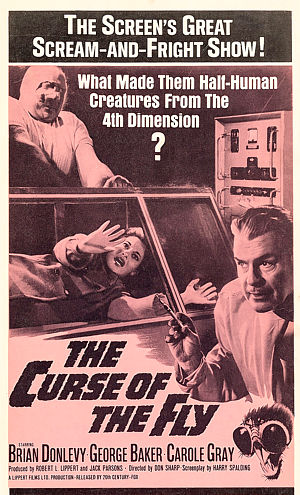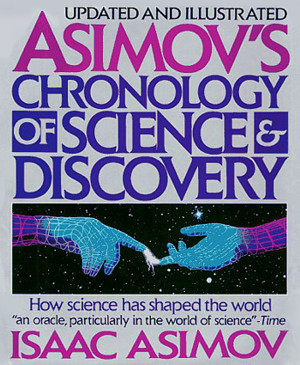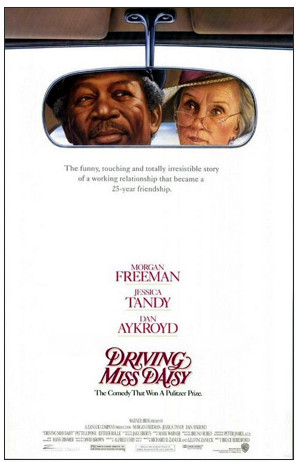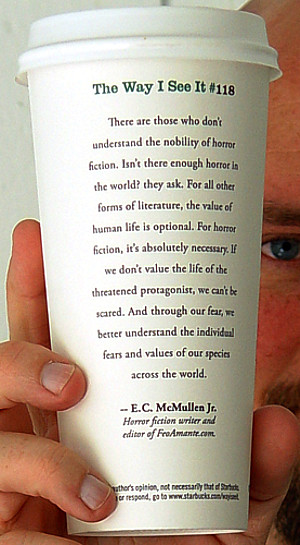 |
 |
SCIENCE MOMENTS by |
 |
All THE FLY SCI-MO
 THE FLY - 1958
THE FLY - 1958
Short Story by George Langelaan
Screenplay by James Clavell
Directed by Kurt Neumann
The idea of teleportation has been a favorite of sci-fi forever,
right up there with warp drive, but the details have always been glossed over and this is no exception.
 SCIENCE MOMENT By SCIENCE MOMENT ByKELLY PARKS |
I'm sure you've heard of "E = mc2" ? This famous Einstein equation tells you how much energy you get when you convert matter into energy. "E" is energy, "m" is mass and "c" is the speed of light.
If we use metric units, a full grown man masses about 85 kilograms. The speed of light is pretty close to 300,000 kilometers / second or 3 X 108 meters / second so plugging these numbers in gives us an energy of 7.65 x 1018 kg-m2/sec2 or 7.65 x 1018 Joules. In case that means nothing to you, it's equivalent to 1800 megatons of TNT (about 90 good, old-fashioned H-bombs).
Not exactly the kind of experiment you want your husband doing in the basement.



 RETURN OF THE FLY - 1959
RETURN OF THE FLY - 1959
Based on Original characters by George Langelaan
Screenplay by Edward Bernds
Directed by Edward Bernds
Teleportation, even as described in a bad movie like this, isn't quite impossible. But let's consider the technique:
 SCIENCE MOMENT By SCIENCE MOMENT ByKELLY PARKS |
This device works by scanning you and recording the position of every particle in your body, disintegrating you and sending you and your data to the receiver, which reassembles you.
So for each atom in your body you need three numbers (x,y,z) to indicate location, plus another number to indicate what kind of atom it is and maybe one more to indicate the atom's state (ionized, etc.). All these numbers represent about 20 bytes (in computerese) of information. Take that times the number of particles in your body (something in the neighborhood of 3 x 1027 atoms) and you get 6 x 1019 gigabytes of information storage required each time. A good, top of the line computer (for March, 2000 -feo.) comes with a hard drive that can store about 20 gigabytes. You'd need 2.8 x 1018 computers (enough for every person on Earth to have more than 465 million computers each). Think of the download time! Each transmission would take so long it'd be quicker to walk.
 SCIENCE MOMENT By FEO AMANTE |
As of March 2012,
a good top of the line personal desktop computer can store 128 gigabytes on its RAM alone and 3 terabytes, or 3000 gigabytes on its single hard drive.
One 3 terabyte hard drive per computer is equivalent to the year 2000 population of 6 billion people now require a little over 33,100,000 computers each or 3.3 x 106.
That is still ridiculously steep, but also consider the enormous shave of nearly 431 million computers, per person, off of Kelly's watermark in the space of only 12 years.
Also, and this is crucial to all computing, consider that amount of information further packaged by a lossless compression algorithm. Since such computer technologies have existed for decades and continue to improve, this is well within the realm of possibility, even a likely necessity. At this rate, and with the ever increasing speed of technology, we should be ready for human teleportation by 2018.
Don't take that as a given though. We still don't have Gerard O'Neill style space station cities, colonies on the Moon and Mars, and flying cars!
Phooey.
UPDATE: August, 2015
Samsung announces their new Solid State Drive (SSD), at a size of 2.5 inches (laptop-size) that holds an uncompressed 16 terabytes.
This drive, preparing for mass production, will go on sale as soon as the major operating systems (Windows, Mac, Linux) can handle that much storage space on a single drive. Or, by the time you read this.
In addition to its size, it is also the fastest drive ever made for commercial use, thanks to its latest 48 layer flash drive contained within the 3.5 inch SSD.
In my last update of March, 2012, the fastest SSD drive was capable of handling 90,000 IOPS (input/output operations per second - how many tasks can be performed in a second).
Want to get an astounding sense of the world of technological advances all brought down to a micro scale? When you consider that every discovery, all history, every iota of planet earth's combined information we have is stored on hard drives somewhere, you get a remarkable (and somewhat unsettling) sense of how crucial this technology is to all of us. Take a closer look at the narrow slice of scientific achievement and engineering of the modern hard drive in the article, HUMAN PROGRESS. |
The new consumer model Samsung 16 terabyte SSD drive handles a minimum of 2,000,000 IOPS - over 200 times faster than current laptop SSD consumer models.
So let's put this new data into perspective.
Back when this Science Moment was wrote in 2000, a desktop computer topped out at a max of 20 gigabytes per hard drive. Kelly determined that you'd need 2.8 x 1018 computers to store the amount of info required to transmit a single person. Referencing a total world population of about 6 billion people in 2000, he figured it out to around 465 million computers per person.
In 2012, staying with that 6 billion person figure, a computer with the latest 3 terabyte (3000 gigabyte hard drive) brought that per person number down to 150 million computers per person.
For our latest update, we now have the faster 16 terabyte drive (16,000 gigabytes). That much space on a hard drive is equivalent to a year 2000 person having 800 single hard drive computers. At 16 terabytes, the single hard drive computer per person metric has now dropped to about 620 thousand computers per person or 6.2 x 105.
Hella steep? Sure! But consider that in the space of only 15 years, that is a minus of over 464 million computers (2.8 x 1018) per person.
Since 2012, that is a cut of nearly 150 million computers per person! In just three years!
An actual matter transmitter would be based upon a wide range of figures and technology, of course, firmware and software, much of which probably hasn't been invented yet. But based solely on whether or not our hard drive tech could handle the storage capacity of matter transmitter machines sending humans, my original prediction of storage readiness by 2018 is on course.



THE CURSE OF THE FLY - 1965
Based on Original characters by George Langelaan
Screenplay by Harry Spalding
Directed by Don Sharp
When you talk about teleporting someone from London to Montreal, you have to worry about momentum: Conservation of momentum, that is.
 SCIENCE MOMENT By SCIENCE MOMENT ByKELLY PARKS |
At the equator the earth is spinning at almost half a kilometer per second. The farther north you go the lower the velocity but the real problem is that London and Montreal are at different latitudes and therefore moving at different velocities. The difference looks small on a map but in fact it works out to about 130 km kilometers per hour or roughly 80 mph.
That means Henri would appear in the Montreal booth and immediately splat against the glass.
 SCIENCE MOMENT By FEO AMANTE |
Nope.
Why?
Momentum?
In a machine built to Catch and Stop the momentum of the speed of light? Convert that energy to matter, assemble said matter into a living human being? Yet said contraption would be powerless against the comparative insignificance of the momentum of energy moving across earth's latitudes?
At the Speed of Light?
THE CURSE OF THE FLY makes it clear that Henri is vaporized "atom by atom." Those atoms are pure energy (Photon for 2, and 2 Photon. Me for you, and you for Me ... anyway) as they are transmitted at the speed of light (through time and space) - to Canada. At that point, the transporter caught Henri-Energy - transmitted at the speed of light - and reconstituted him back into Henri-matter. The law of momentum - in this example - would apply to Henri-matter, not Henri-energy. The movie makes no claims about also transmitting the matter's speed. So Henri's speed is the speed of light.
Light doesn't move any faster in London than it does in Canada, though that would be pretty funny!
Also in the previous Science Moment for RETURN OF THE FLY, Kelly only calculated for x,y,z to indicate location (X), plus another number to indicate what kind of atom it is (Y) and maybe one more to indicate the atom's state (Z - ionized, etc.). Calculating for the additional "Body in Motion at the moment of Transfer" (t), adds unnecessary complexity without necessity.
Imagine people on the U.S.S. Enterprise getting beamed down to the planet's surface at Impulse or orbital speed?
Also, moving at the speed of light over that distance, Henri arrives in Montreal before he's through leaving London.



| Continued on Page 2 | |||
| 1 | 2 | ||
This article copyright 2000 - 2021 E.C.McMullen Jr.
| HERE WEAR ONE OF MINE | |
| ARTICLES! OF! INTEREST! | |||
 |
 |
 |
|
| ARE WE MAKING HUMAN PROGRESS? |
SEX WON'T SELL YOUR GENRE MOVIE | HOLLYWOOD RACISM | |
| FEO AMANTE'S HORROR THRILLER Created by: E.C.McMullen Jr. COME FOLLOW ME @ |
| Amazon |
| ECMJr |
| Feo Blog |
| IMDb |
| Stage32 |
| YouTube |
| Zazzle Shop |




